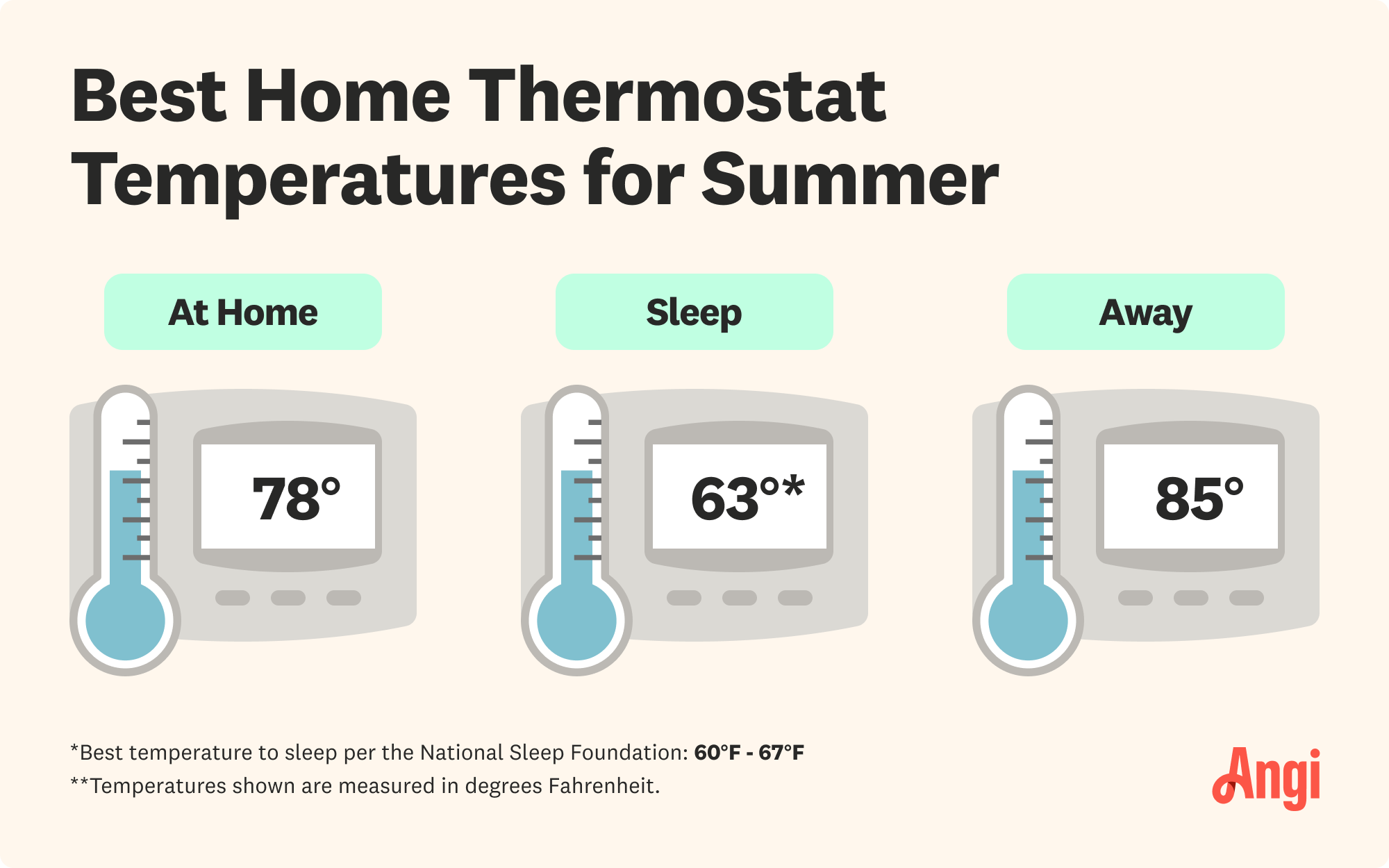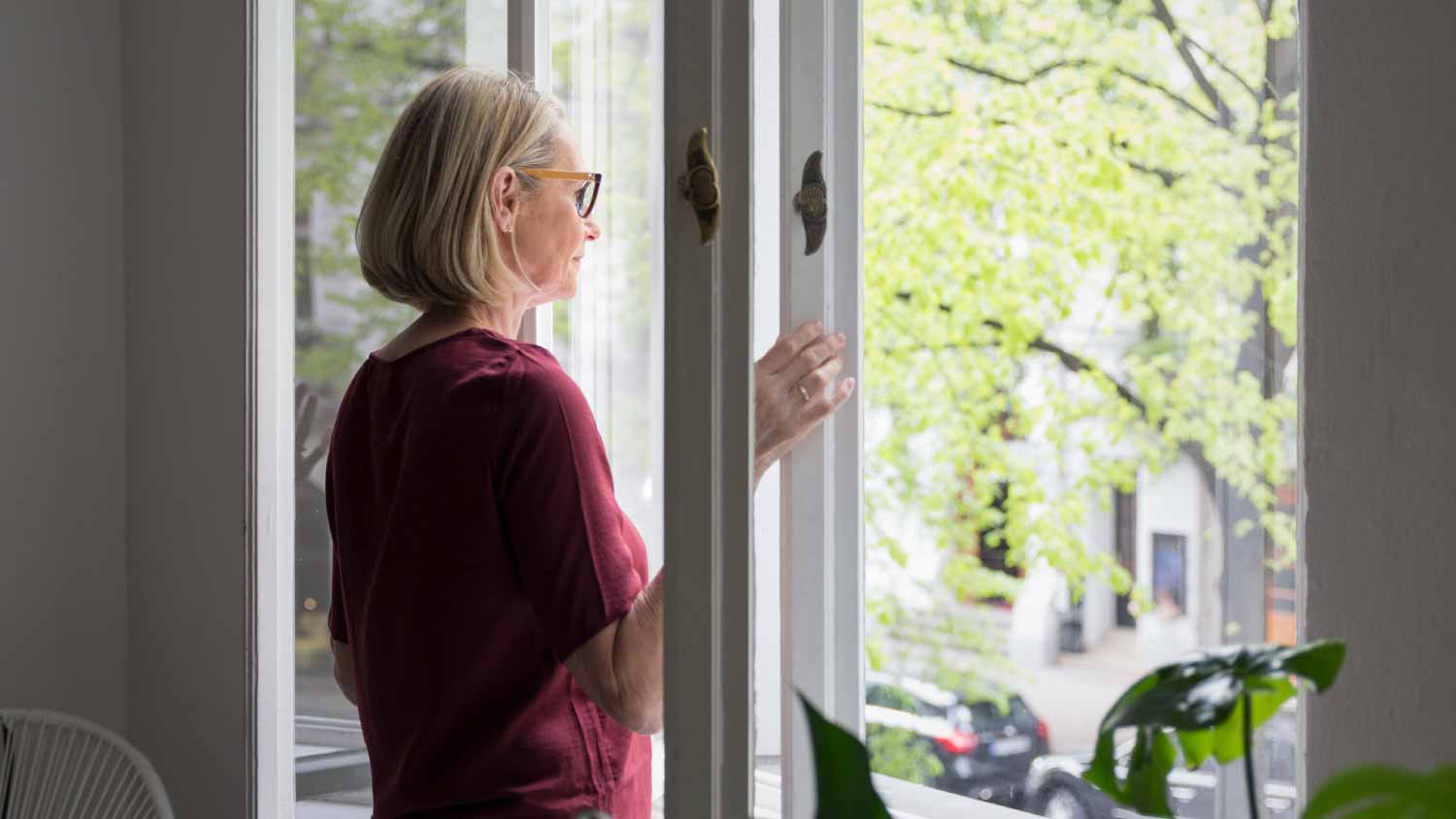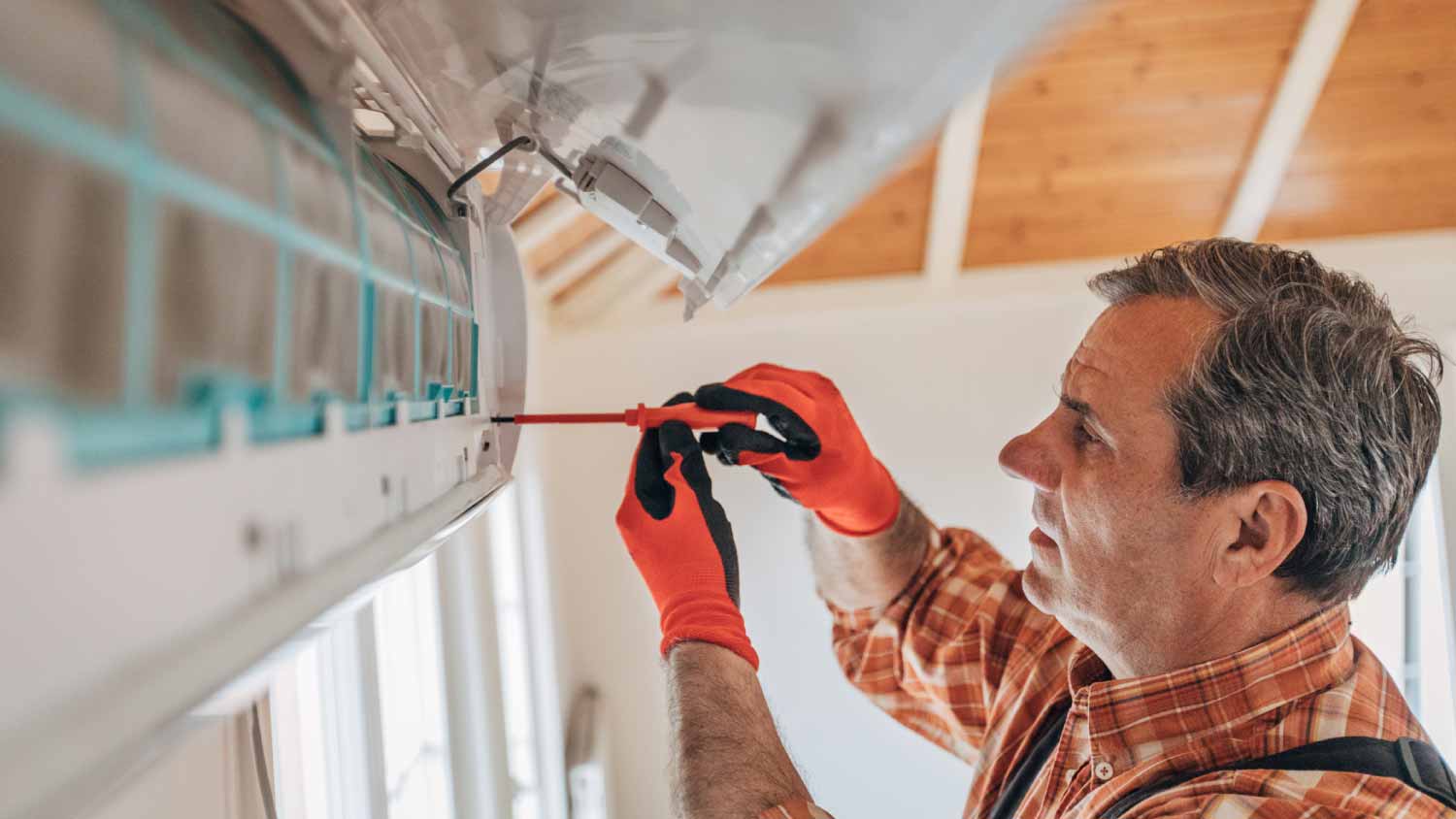What Is the Best Temperature to Set Your Air Conditioner to in the Summer?
Stay cool and energy efficient at the same time


The U.S. Department of Energy (DOE) says the best summer temperature for your air conditioner when you’re at home is 78 degrees Fahrenheit.
Aim for between 60 and 67 degrees Fahrenheit for summer sleeping.
When you’re away, 85 degrees Fahrenheit is as warm as it should get.
When hot weather is fast approaching, you might think about what temperature to set the air conditioner in the summer. While you might want to crank the AC to the coldest temperature possible, that won’t be very energy efficient—and your wallet might take offense. Keep reading for suggestions on how to keep your home cool while not spending a ton on cooling costs.
What Is the Recommended Temperature for Your AC in the Summer?

According to the U.S. Department of Energy (DOE), the most cost-effective AC setting for summer is 78 degrees Fahrenheit when you are home and awake. Generally, the more energy efficient you are, the less you spend on running your unit. Being more efficient with your energy usage is one way to reduce your electric bill overall.
When you leave the house during the summer for long periods, like for work, raising the temperature a few degrees is recommended to become even more energy efficient. According to the DOE, you can save up to 10% on yearly cooling costs if you adjust your thermostat by 7 to 10 degrees when you leave for long periods. On the way home (or once you return), you can turn this back down to cool your home to a more comfortable temperature.
This temperature change might come as a shock to you and your family, especially if you’re used to it feeling like Antarctica in your home when it’s hot out. To combat this, you can slowly adjust your thermostat up a few degrees at a time over the course of a few weeks until you reach the 78-degree mark.
It’s important to remember that these are recommended guidelines. These might not work for everyone in every circumstance, but keeping these in mind will help keep your energy usage low. Factors like location, the type of insulation your home has, members of your family, the pets you have, and the time of day can all play a part in where you set your thermostat.
Best AC Temperature for Sleeping
The National Sleep Foundation says that the best temperature to sleep is between 60 and 67 degrees Fahrenheit. This helps promote the best sleep possible, along with other factors like limiting caffeine intake and having a dark, quiet sleep space.
So what does this mean for your energy bill? Because you’re most likely running the air conditioner more at this time, you might be concerned about the increased cost. The good news is that because you’re limiting your usage during the day, the increased usage at night shouldn’t shock your energy bill overall.
Ways to Save on Energy Costs and Keep Your Home Cool

Depending on your summer, you might think setting your thermostat to 78 degrees is impossible. While a setting of 78 seems like you’ll be living in the Sarraha instead of the Arctic Circle, there are some tips and tricks you can use to cool your house down without AC and without sacrificing your energy consumption.
Use Ceiling Fans
According to the DOE, installing a ceiling fan can allow you to set your thermostat about 4 degrees warmer without noticing a difference in temperature. Fans circulate the air, and even though they don’t cool the air they are moving, the moving air will help keep you feeling cooler by creating an indoor “wind chill.” If a ceiling fan is out of the question, you can instead use a standing fan or box fan to do the job.
Open a Window
Depending on your climate, opening a window is a great way to cool down your home. Of course, this might not be possible during the daytime hours when the sun is out and the temperature is the highest it’ll be for the day. However, if the temps drop at night where you live, you can give your AC a break from running and open a few windows to let the outside air naturally circulate throughout your home. Try sleeping with your windows open at night to fall asleep with the sounds of nature and stay cool all night long.
Close Your Shades
During those daytime hours when the sun is in full effect, it’s tempting to want to keep your blinds and curtains open to see the beautiful rays. Unfortunately, doing so can actually make your home hotter. One helpful indoor cooling tip is to use blackout curtains in rooms that you’re not in during the day to help reduce the heat coming in.
Install a Programmable Thermostat
There are many types of thermostats available to install in your home to set your AC’s temperature. Installing a programmable thermostat is a smart way to control your AC without lifting a finger. These devices can lower or raise the thermostat temperature based on the time of day once you’ve configured the settings, making it easy and convenient to remain energy efficient.
Smart thermostats are another great way to maintain the temperature in your home. These gadgets are not only programmable, but they can learn your routine and self-adjust based on them. These also track your usage over time, making it simple to review when you’re using the most energy.
Regardless of whether you use a simple programmable thermostat or a sophisticated smart thermostat, these are designed to help you manage your home’s temperature, both when you’re home and away. The cost of installing a thermostat can vary depending on what type you choose, but this easy adjustment can save you money in the long run.
Install HVAC Zones in Your Home

Most homes have one thermostat that controls the temperature throughout the entire home. If you have a larger or multi-story house, an upstairs room might be very hot during the summer while the basement is more frigid. If this seems to be a problem in your home, installing an HVAC zone will help even things out.
HVAC zones help tell the central thermostat what the rest of the house feels like. This is very helpful, especially when you are in rooms that are very far away from the main thermostat. Luckily, there are a few ways to open up the lines of communication.
First, you can install an additional thermostat (or two) in your home to control the temperatures in different sections of the house. What’s more convenient: smart thermostats often have a sensor you can place in the room instead of installing a whole new thermostat. These sensors can talk to the main thermostat. When switched to the sensor, the AC will run based on the temperature of the room the sensor is in versus the main thermostat.
Another way to maintain HVAC zones in your home is to have two HVAC systems. By having two systems, you can more efficiently control the overall temperature of your home so you don’t have differing temperatures. This is especially helpful if you do not have central air conditioning and instead rely on window units.
Install an ENERGY STAR® AC Unit
ENERGY STAR® appliances are considered energy efficient by the U.S. Environmental Protection Agency. These appliances include refrigerators, washing machines, and you guessed it—air conditioners. The air conditioners that are ENERGY STAR® certified have been found to help keep your energy consumption low, making them an excellent choice to install in your home.
ENERGY STAR®-qualified air conditioners have higher SEER ratings, at least 14.5. You can tell if your appliance is ENERGY STAR® certified by looking for the ENERGY STAR® label. Having one of these high-efficiency air conditioners can help reduce your energy bills and are reliable, even in extreme temperatures.
Use a Dehumidifier
Summertime temperatures often bring more than heat; they tend to bring humidity too. Your house can feel wet, sticky, and just plain uncomfortable if the humidity is too high. Air conditioners help with moisture in the air, but if you’re keeping the temperature up to save on energy bills, consider running a dehumidifier in the more humid parts of your home to pull some of the moisture out of the air.
ENERGY STAR® recommends that indoor humidity be between 30% and 50%, but ideally no more than 60%. High humidity can cause mold to grow, germs to stay in the air longer, and can even cause you to feel hotter.
Check Your AC Before Running It Full Time This Summer
Now that you know where to set your air conditioner, it’s time to start thinking about getting it ready for the season. Below are some quick tips to prepare your AC for summer that you can do yourself:
Schedule an AC tune up to catch any small issues that might cause you problems when temps start to soar.
Remove any winter air conditioner covers that are on your unit before turning your AC on.
Inspect your unit for damage that was caused during the harsher months.
Clear out any dirt and debris from around your unit.
Change the air filters to maintain good indoor air quality.
Clean your indoor air vents for good airflow.
Adjust your thermostat to AC mode and an appropriate temperature.
Once you’ve taken these steps and your air conditioner is running, there are a few things you should look out for that can signal a problem. Consult a certified HVAC professional in your area if you experience any of these problems while running your AC.
No airflow or restricted airflow
Thermostat malfunction
Unusual banging, clanking, or other sounds coming from vents or the AC unit
Unpleasant smells coming from the ductwork
By practicing these summer air conditioning tips, you can ensure that your AC is working in tip-top shape and that your electric consumption won’t break the bank when it’s time to cool down in the summer.





- Furnace Repair
- Air Conditioning Repair
- HVAC Repairs
- Furnace Installation
- Wood & Pellet Stove Repair
- Dehumidifier & Humidifier Repair
- Heat Pump Companies
- Swamp Cooler Repair
- Wood Stove Services
- HVAC Companies
- Commercial A/C Repair
- Geothermal Installation
- Air Conditioning Installation
- Boiler Repair
- 24 Hour Furnace Repair
- Geothermal Repair
- Heat Pump Repair
- Humidifier Installation
- Thermostat Repair
- Thermostat Installation
- Nest Installation
- Heating & Cooling
- Heating Repair
- Furnace Cleaning
- Furnace Tune-Up
- HVAC Technicians
- Subcontractors
- Furnace Maintenance
- Plumbing & Heating Companies
- Wood Stove Inspection
- Mini Split Installation
- Wall Heater Repair
- Duct Installers
- 9 Energy-Efficient Ways to Cool a Home
- Is It Bad to Keep Turning Your AC On and Off?
- 13 Cool Tips to Reduce Air Conditioning Costs This Summer
- 11 Reasons Your AC Is Blowing Hot Air
- 11 Home Heating Mistakes You Didn't Know Were Costing You
- 4 Reasons There’s Air Coming Out of Vents When the AC Is Off in Your House
- Breathe Easy: 10 Tips for Improving Your Indoor Air Quality
- Heat Pump vs. Air Conditioner: What’s the Difference?
- Discover 3 Different Types of Thermostats and Pick the Right One for Your Home
- The Ideal Indoor Humidity Level for Your Home










